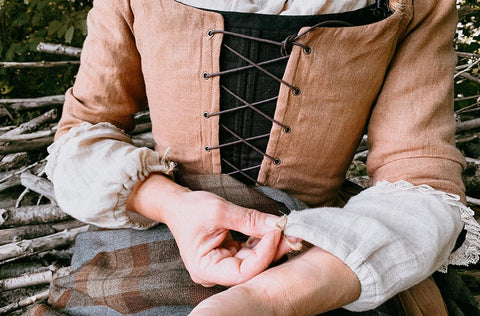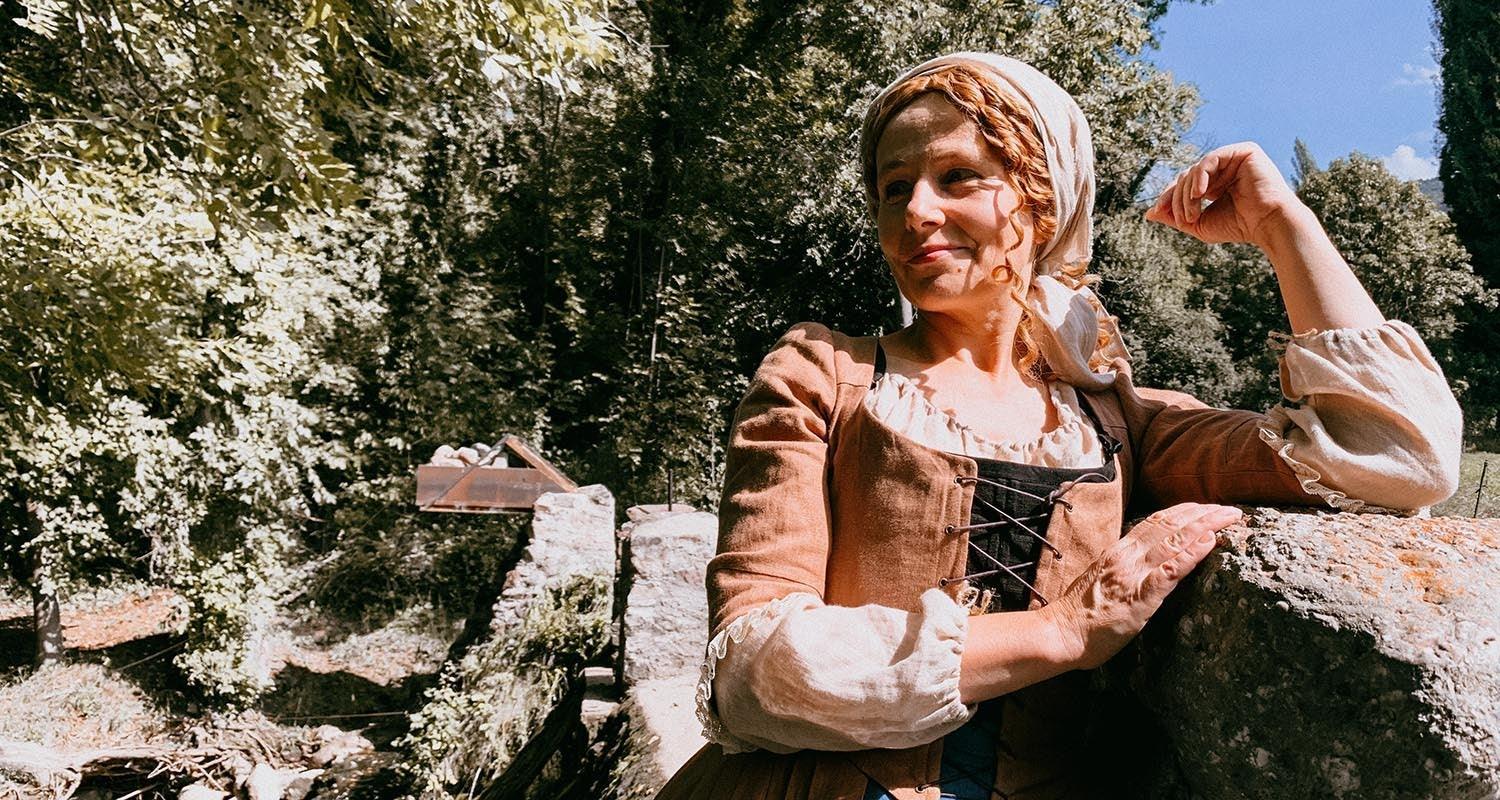The 18th century was a time of great change, but for many rural peasants and urban workers, daily life remained humble. Clothing was simple and practical, often passed down through generations. Unlike the sumptuous silks and decadent decoration of aristocratic fashion, the common folk relied on durable fabrics like linen and wool, in limited colors. Their attire focused more on functionality than trends. Yet even the plainest dress or shirt could carry stories, memories, and a sense of belonging.
This article explores the ingenuity of 18th century peasant clothing and one artisan's quest to recreate that experience today through linen dresses inspired by this bygone era. By using time-tested materials and techniques, I humbly try to pay homage to the resourcefulness and perseverance of everyday people in the 1700s. Their clothing connected them to past and future generations through shared garments that withstood hard use. Beyond covering the body, these textiles wrapped their wearers in a tactile piece of family tradition and offered a sense of humble continuity in a rapidly changing world.

Materials for Peasant Dresses
The materials I choose for my 18th century peasant dress creations are typically linen and wool, with occasional use of cotton. These were common, affordable materials for rural women of the time. Linen is a particularly durable fabric that allows dresses to be passed down and reused over generations. Wool provides warmth during cold seasons. Cotton could be used when available, but was less accessible and affordable than locally produced linen and wool. The simplicity and durability of these raw materials suited the practical lifestyles of country women. Plain linen and wool dresses would be valued and cared for within families. My use of these textiles helps recreate peasant fashions of the era.
Simplicity
The simplicity and timeless quality of 18th-century peasant garments is what draws me to recreate them. Peasant women of the era did not have the means to buy elaborate dresses made of luxurious fabrics. Their clothing was humble and functional, sewn from basic materials like linen and wool that were durable and could last for generations.
Rather than following the latest fashions, rural women often wore handed-down dresses that retained a classic style. It was common for clothes to be passed down from sister to sister, mother to daughter, even grandmother to granddaughter. A new dress was a rare luxury when the existing garments were sturdy enough to be reused again and again.
This passing down of simple, solid-colored dresses is part of what gives 18th-century peasant clothing its appeal. I strive to recreate that timelessness in my own costumes, using natural fibers like linen that imbue the pieces with a classic, enduring look and feel. My hope is that the humble nature and quiet beauty of these fashions still resonates centuries later.

Affordability
The peasant women of 18th-century France often could not afford to purchase new dresses. The cost of fabrics and the workmanship involved in creating intricate dresses made new clothing prohibitively expensive for many rural and working-class women.
Instead, durable fabrics like linen allowed dresses to be handed down and worn for generations. Young women would often wear the dresses of their mothers, grandmothers, and older sisters as hand-me-downs. This practice of reusing and repairing dresses was essential to stretch the clothing budget for peasant families.
While the nobility and upper classes could afford the latest expensive fashions, peasant women relied on timeless styles and well-made heirloom dresses that extended the precious lifespan of their limited wardrobes. Their humble dresses tell a story of frugality, resourcefulness, and making do with what was available to them. Simple frocks made from organic materials encapsulate the reality of dress for the working poor in the Age of Enlightenment.
Durability of Linen Allowed Clothes to be Reused
The materials I choose for my creations, linen and wool, sometimes a little cotton, point precisely towards my objective of recreating peasant clothing. I like to create simple, solid 18th century clothes that were often passed from generation to generation. To buy a new dress was often a luxury that the peasant women could not afford. But linen, a strong and durable material, allowed them to reuse their sisters' clothes, their mothers, or their grandmothers for a long time. The durability of linen made it an ideal fabric that allowed dresses to be handed down and worn for generations.

CHARLOTTE in Toffee Linen
This morning walk along the irrigation ditch of the Pobleta de Bellvehí was an excellent opportunity to wear the CHARLOTTE model in toffee linen over a steel blue linen petticoat.
CHARLOTTE is an overdress or mantua from the 18th century that is put on directly over the corset and fixed with lace on the front part. Wide-open, it makes the most of the petticoat. I chose for this occasion a color that contrasts sharply with the brown overcoat. This combination of blue and brown is reminiscent of the Outlander tartan pattern in my shawl. The steel blue linen petticoat paired beautifully with the toffee linen overcoat.
The overcoat is made of a sturdy linen that will stand the test of time, while the petticoat offers a pop of color and contrast underneath. Together they make for a fashionable yet functional dress perfect for a summer walk. The lightweight layers are ideal for keeping cool in the summer heat while still maintaining modesty and style.
Accessories
I chose accessories to complement the muted earth tones of the CHARLOTTE dress. Since it was still quite warm out, I selected a lighter weight linen shawl with a large gray and blue tartan plaid pattern. The bold check pattern stood out against the solid linen dress while still keeping with the color palette.
The shawl's blue and gray shades paired nicely with the steel blue petticoat underneath the brown overdress. I find that combining rich earth tones like chocolate browns with bolder accent colors works well for late summer outfits. The lighter tartan shawl provided some visual interest without overpowering the simplicity of the linen dress.
Overall, the accessories aimed to accent CHARLOTTE's understated style and peasant origins. The tartan shawl referenced Scottish influence, common for rural European women's garb in the 18th century. Choosing durable linens and wool tartan allowed a humble yet coordinated look, perfect for a countryside stroll on a summer's end day.
A Simple Linen Undershirt
The shift or chemise was an essential undergarment for 18th-century women. Underneath the mantua or gown, the shift protected the outer layers from body oils and perspiration.
For this summer outfit, I wanted a lightweight and breathable linen shift. Linen was commonly used for undergarments as it is smooth, absorbent, and durable. The sandy colored linen gauze I chose has an earthy, rustic quality suitable for a peasant woman.

The chemise has long sleeves with a cord to tie at the neck and wrists. The loose shape provided comfort and movement for long days working and walking outdoors. A peasant woman would likely possess only one or two shifts, worn repeatedly until they wore out. Fine decorative shifts were reserved for aristocratic ladies.
This basic linen shift complements the overdress beautifully. The neutral earth tone peeks subtly from beneath the neckline and sleeves. Though humble, the shift is fundamental to completing the silhouette and period look. A peasant woman took pride in maintaining her garments, however plain, for as long as possible. Simple stitches and quality fabrics gave longevity. Both sophistication and thrift are embodied in the exquisite practicality of an 18th-century linen shift.
Conclusion
Over the course of history, peasant clothing has often been simple, durable, and designed for affordability and practicality. My recreations of 18th century peasant dresses follow in that tradition. The natural fibers like linen and wool stand the test of time yet require little embellishment. The lack of complex trim or ornamentation reflects the modest means of country folk.
Though without lavish decoration, these dresses maintain their own humble beauty and charm. They represent clothing made to be worn while working and living. Pieces handed down and mended until threadbare, created from necessity rather than vanity. This everyday nature gives them an authenticity money can't buy. While my designs take inspiration from history, their modesty and simplicity feel perfectly at home in the modern day as well. More than just costumes, they embody a spirit, resourcefulness, and pragmatism born of making do with less. Though simple, they have their own quiet elegance and grace. These dresses tell the human stories of rural life among the working class.




